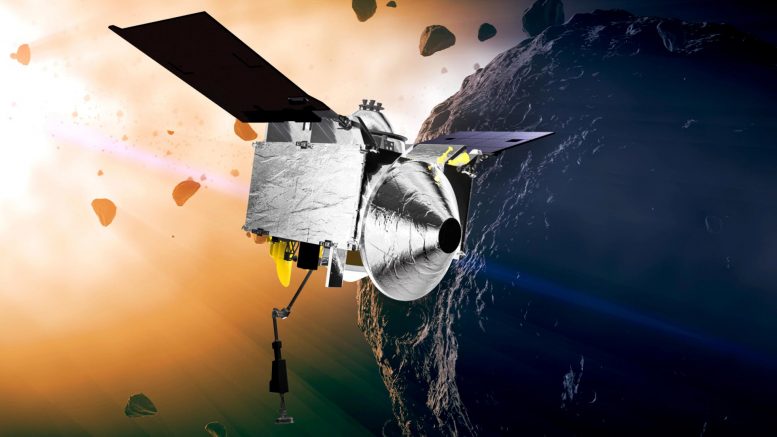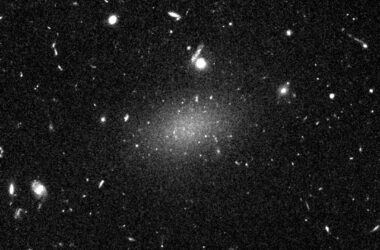
OSIRIS-REx sur le site d’échantillonnage Nightingale.
La surface de l’astéroïde Bennu est constituée de gravats à faible cohésion, selon les données recueillies lors de l’échantillonnage de l’astéroïde par la mission OSIRIS-REx. C’est ce que révèlent deux nouvelles études scientifiques – une en Science et Avancées de la science.
Selon l’étude de Science par Dante Lauretta et ses collègues, environ 250 grammes d’échantillon (9 onces) ont été collectés, qui seront ramenés sur Terre en 2023 pour être analysés en laboratoire.
L’autre étude, publiée dans Science Advances par Kevin Walsh et ses collègues, a analysé les forces subies par le vaisseau spatial, et a constaté que la faible gravité de Bennu a donné lieu à un lit de surface granulaire avec une faible cohésion entre les particules.

La mission de retour d’échantillons d’astéroïdes OSIRIS-REx de la NASA. Crédit : Centre de vol spatial Goddard de la NASA.
Au cours de la mission, le OSIRIS-REx (Origins, Spectral Interpretation, Resource Identification, and Security-Regolith Explorer) spacecraft spent about two years surveying Bennu, a carbonaceous rubble-pile asteroid about 500 meters (1,600 feet) in diameter. After considering the best locations to collect a sample, the mission team selected a site within a 20-meter (65-foot) crater, nicknamed Nightingale.
In October 2020, the spacecraft descended to the surface and collected the sample, Lauretta et al. note. The spacecraft’s Touch-and-Go Sample Acquisition Mechanism (TAGSAM) made contact and began sinking into the asteroid’s surface before it released a jet of nitrogen gas that mobilized sub-surface material and guided it into a collection chamber.
By analyzing imaging and spectral data taken during and after the sample’s retrieval, the team found that sub-surface material is darker and contains more fine particles than the overlying surface. The process produced a debris plume and a new 9-meter-long (30-foot-long) elliptical crater.
Voici à quoi ressemble un coup de poing sur un astéroïde. Le mois dernier, ;” data-gt-translate-attributes=”[{” attribute=””>NASA’s robotic spacecraft OSIRIS-REx descended toward, thumped into, and then quickly moved away from the small near-Earth asteroid 101955 Bennu. This video depicts the Touch-And-Go (TAG) sampling event over a three-hour period. Credit: NASA/Goddard/University of Arizona/Lockheed Martin
Walsh et al. investigated the physical properties of the material up to 10 centimeters (4 inches) below Bennu’s surface, using images and accelerometer data. They reconstructed the forces exerted on the spacecraft in the short span of time between when it first contacted Bennu’s surface and when it released the nitrogen gas.
They found that the near-subsurface material is loosely packed and less dense than the average of the whole asteroid, with very low cohesion. The high porosity and low material strength allow dust and other small particles to move within the sub-surface of the asteroid. Spectral and thermal data gathered during the mission suggests these results apply to the whole asteroid, not just the sampling site.
References:
“Spacecraft sample collection and subsurface excavation of asteroid (101955) Bennu” 7 July 2022, Science.
DOI: 10.1126/science.abm1018
“Near-zero cohesion and loose packing of Bennu’s near-subsurface revealed by spacecraft contact” 7 July 2022, Science Advances.
DOI: 10.1126/sciadv.abm6229


